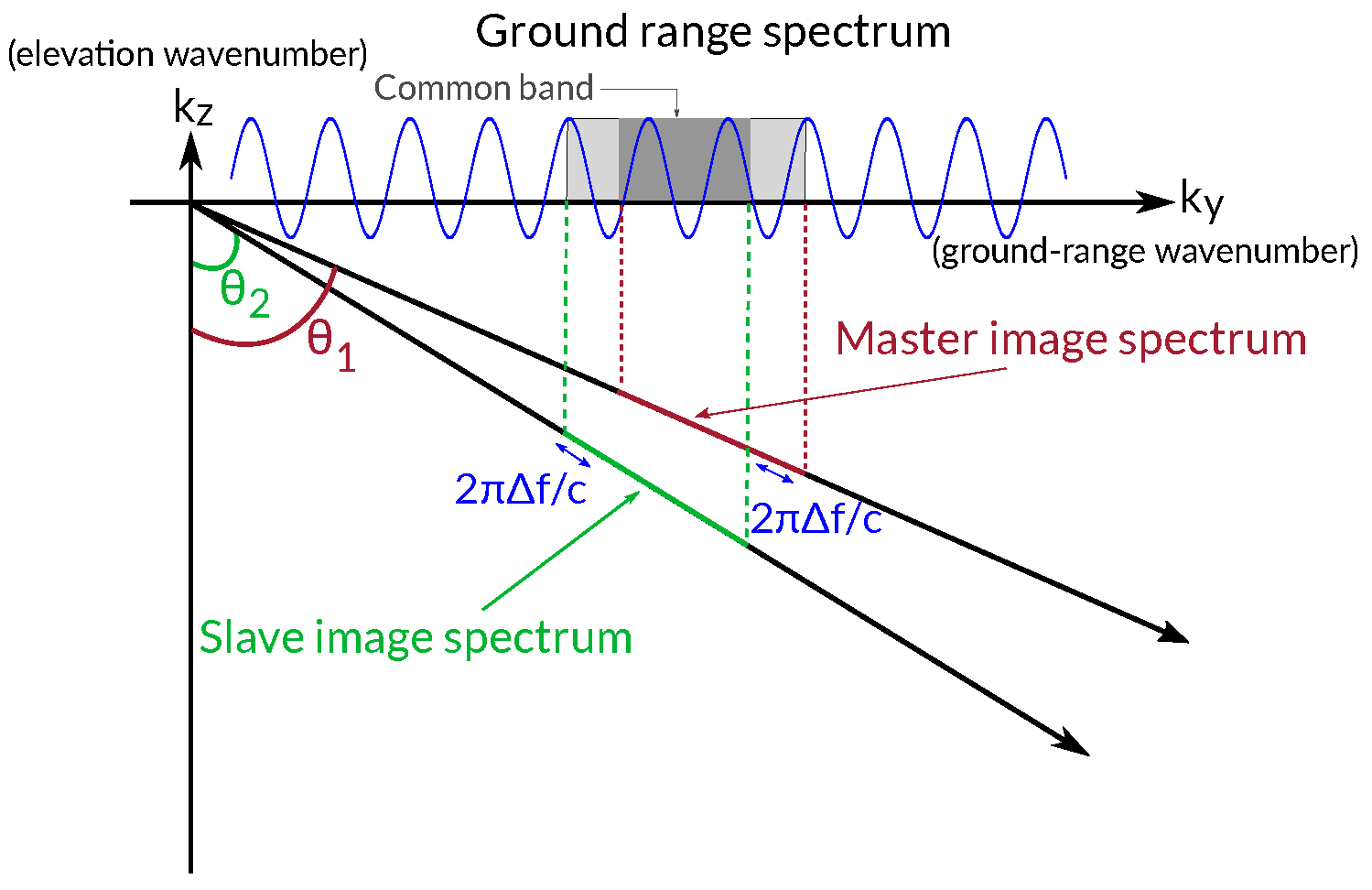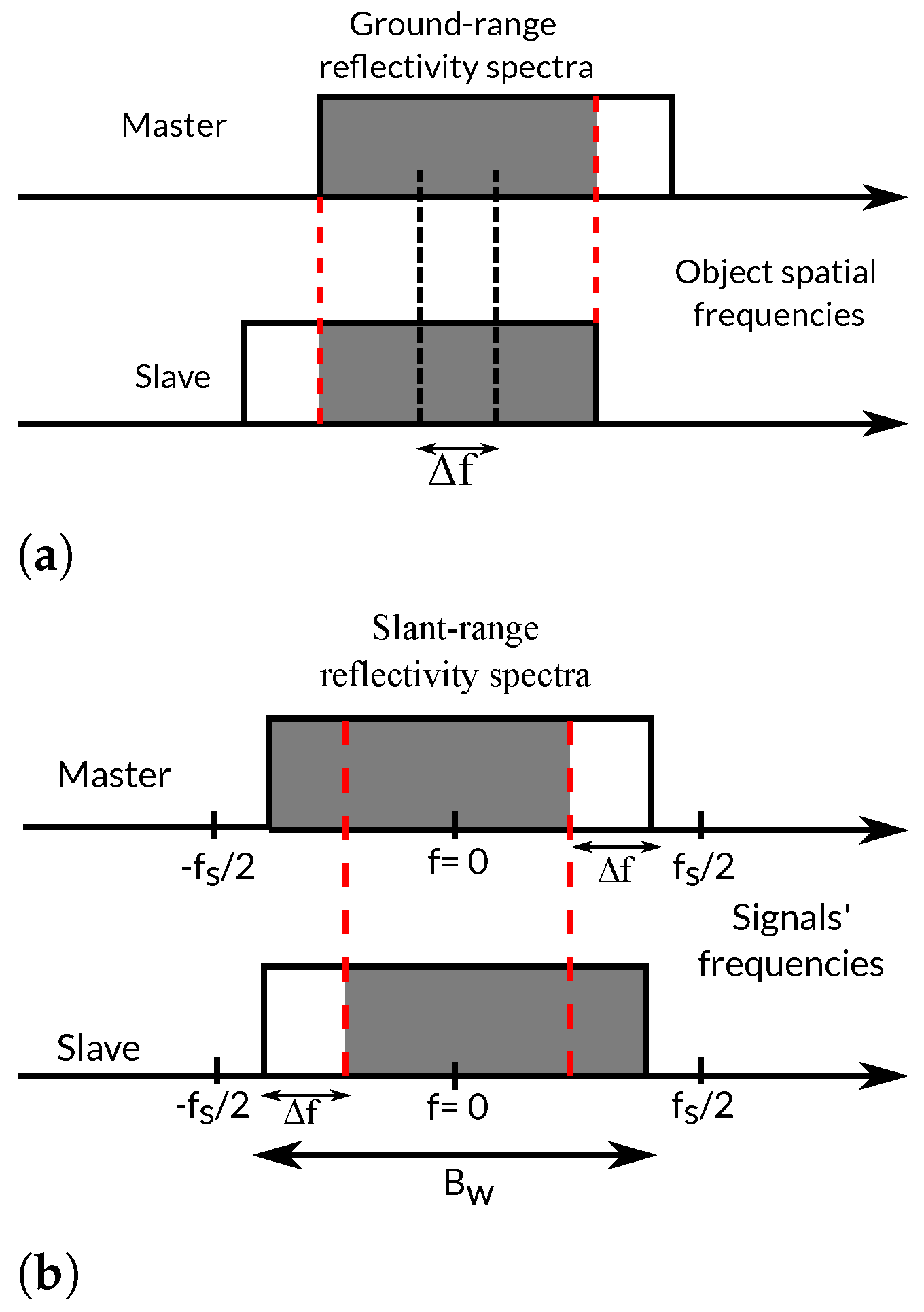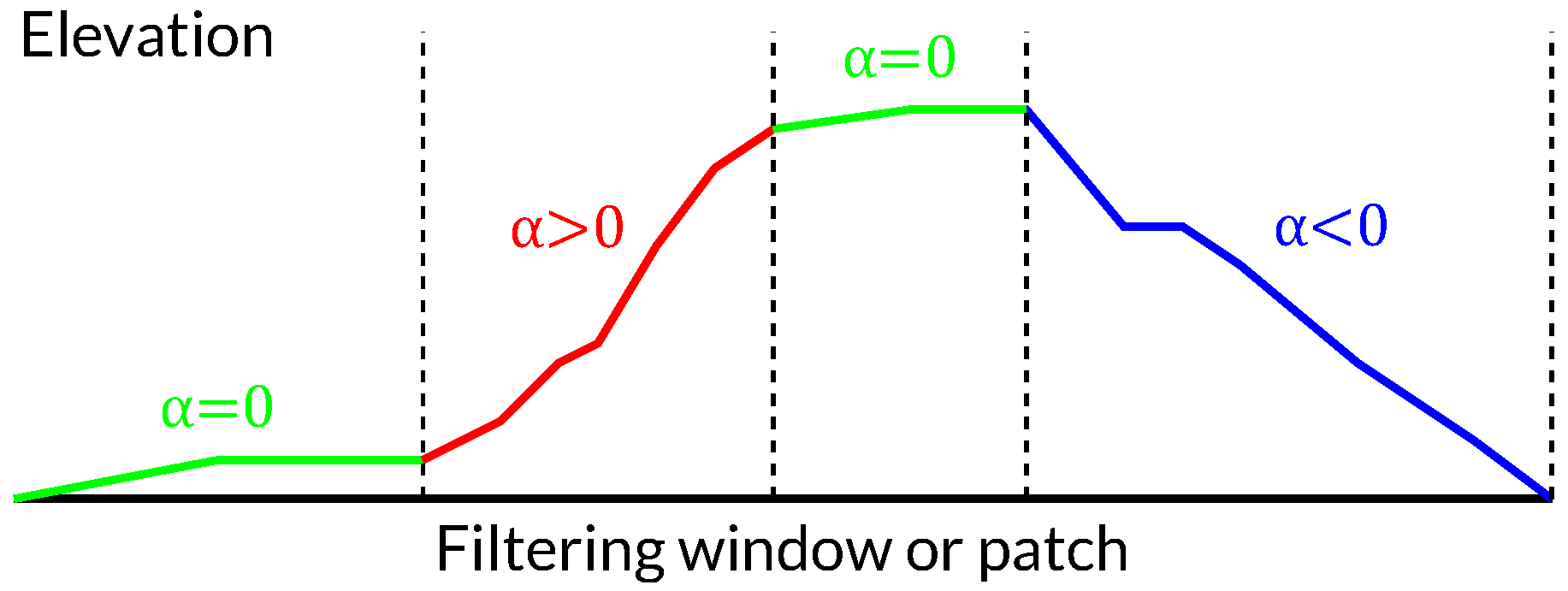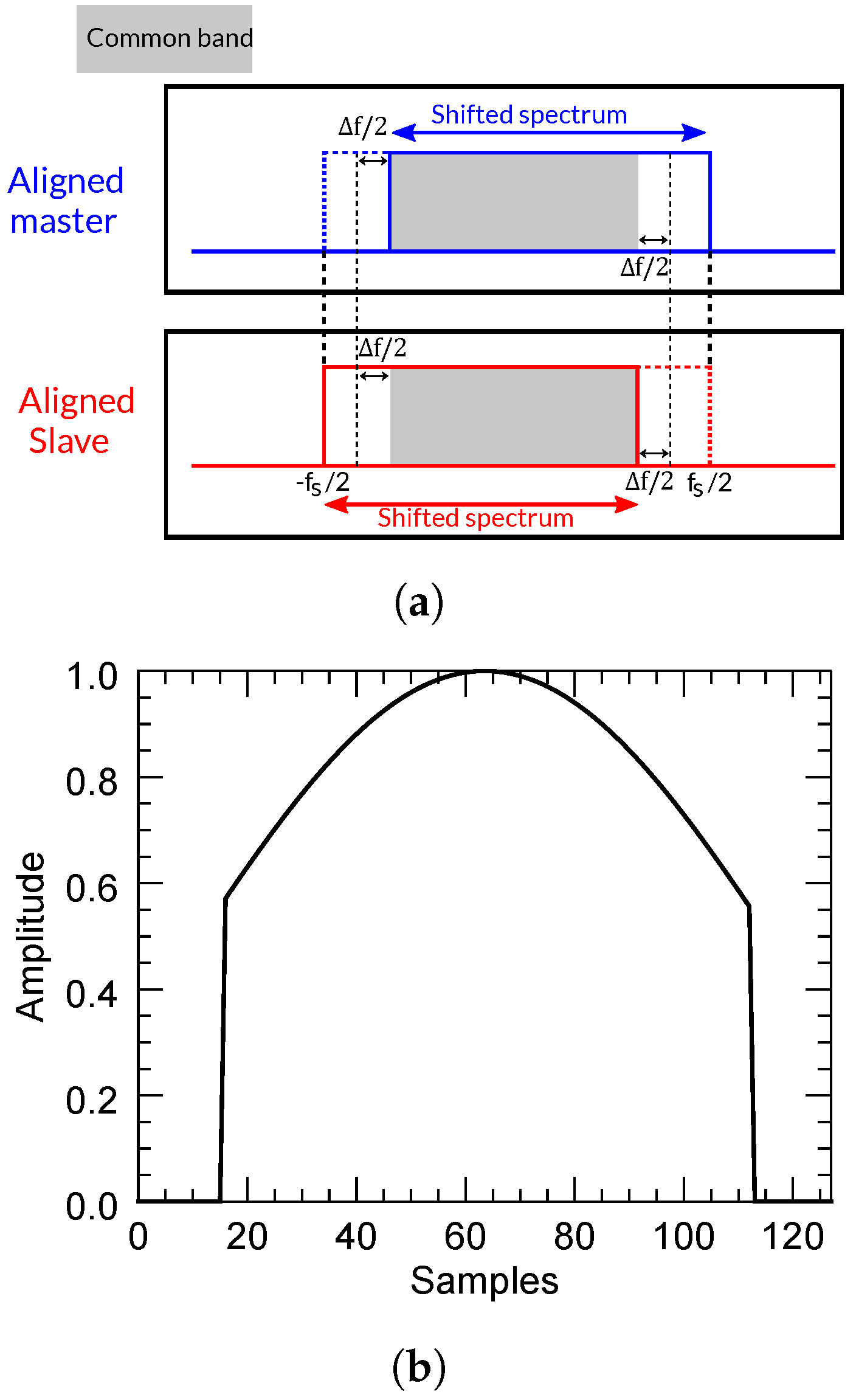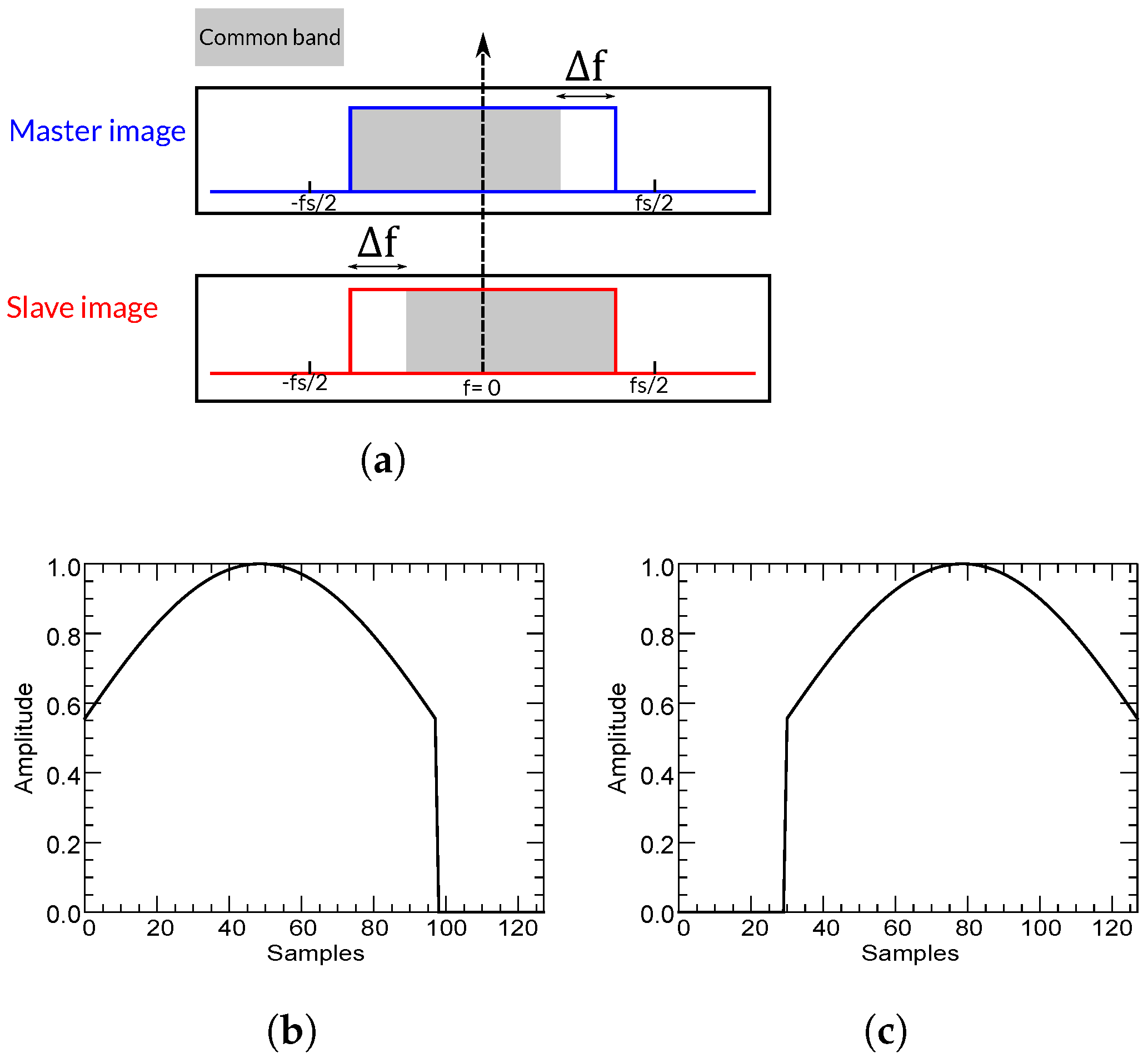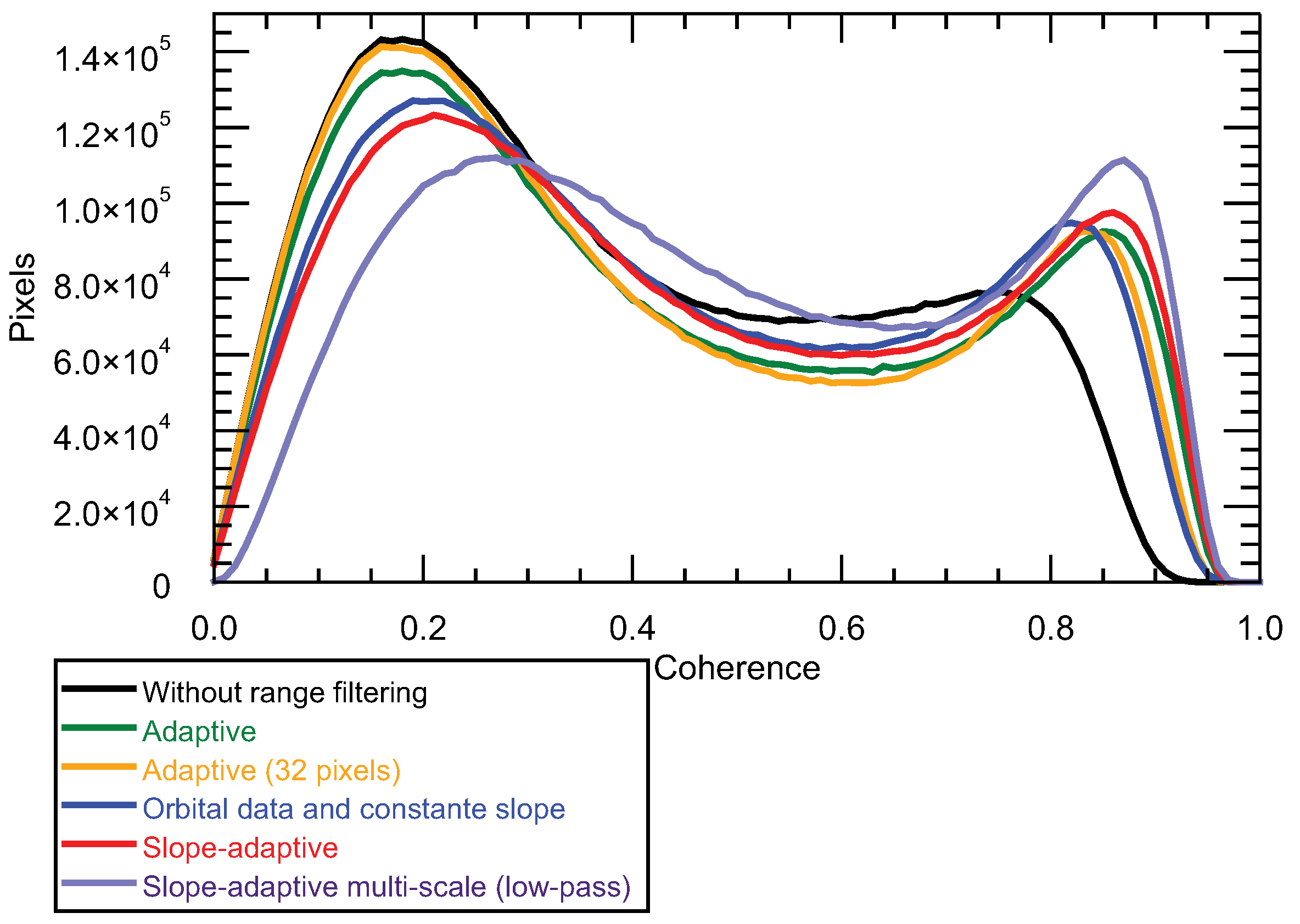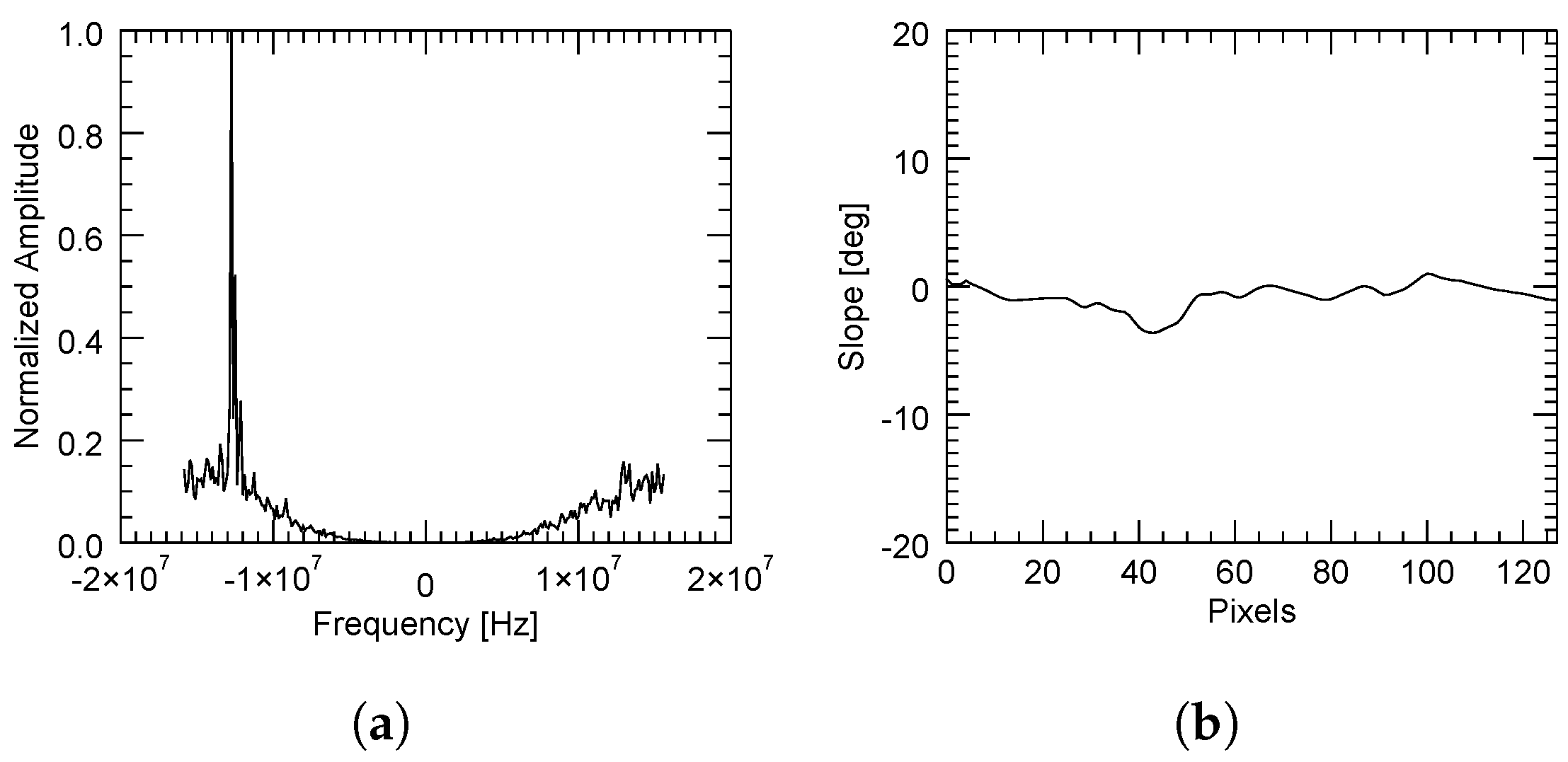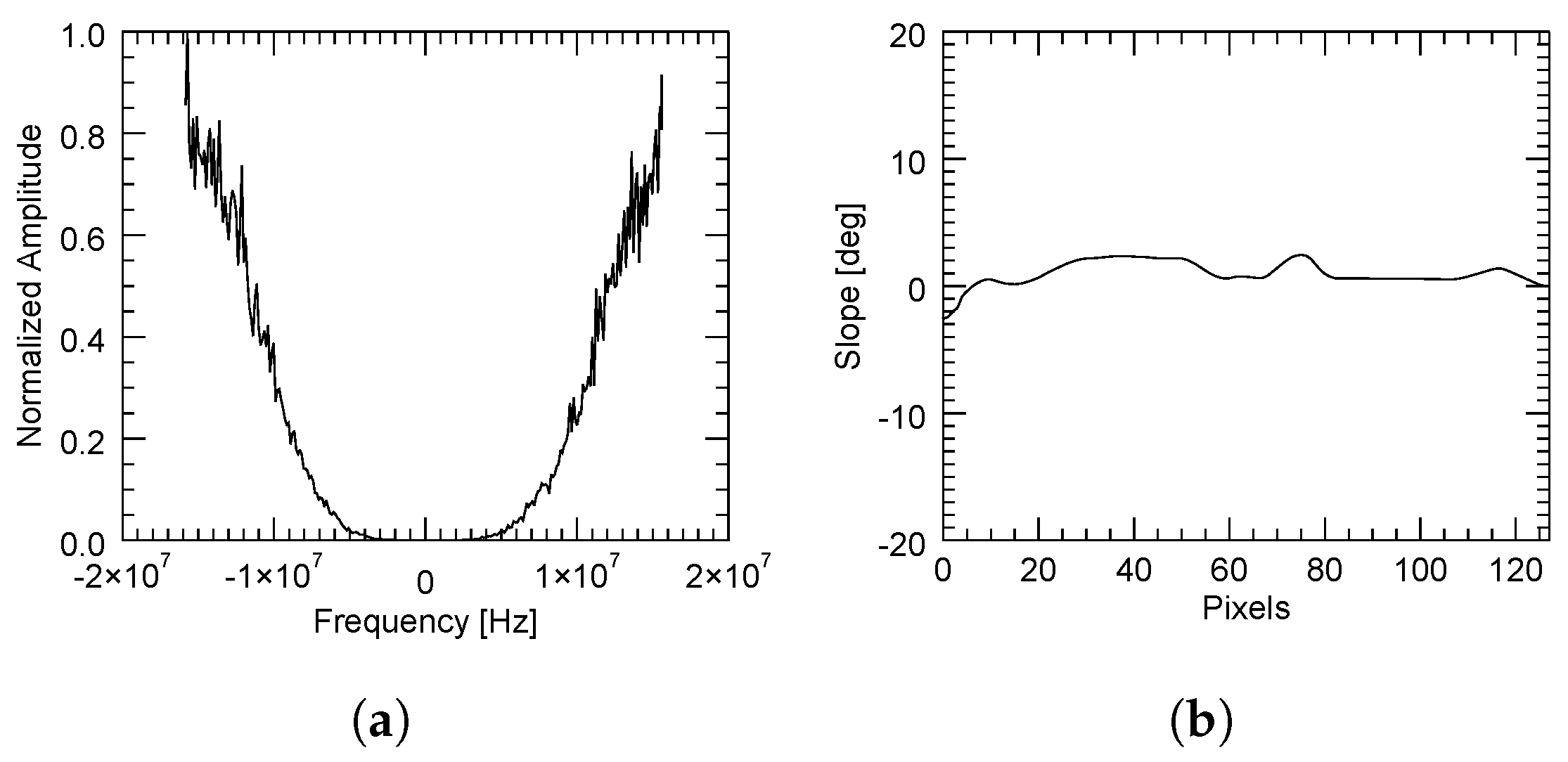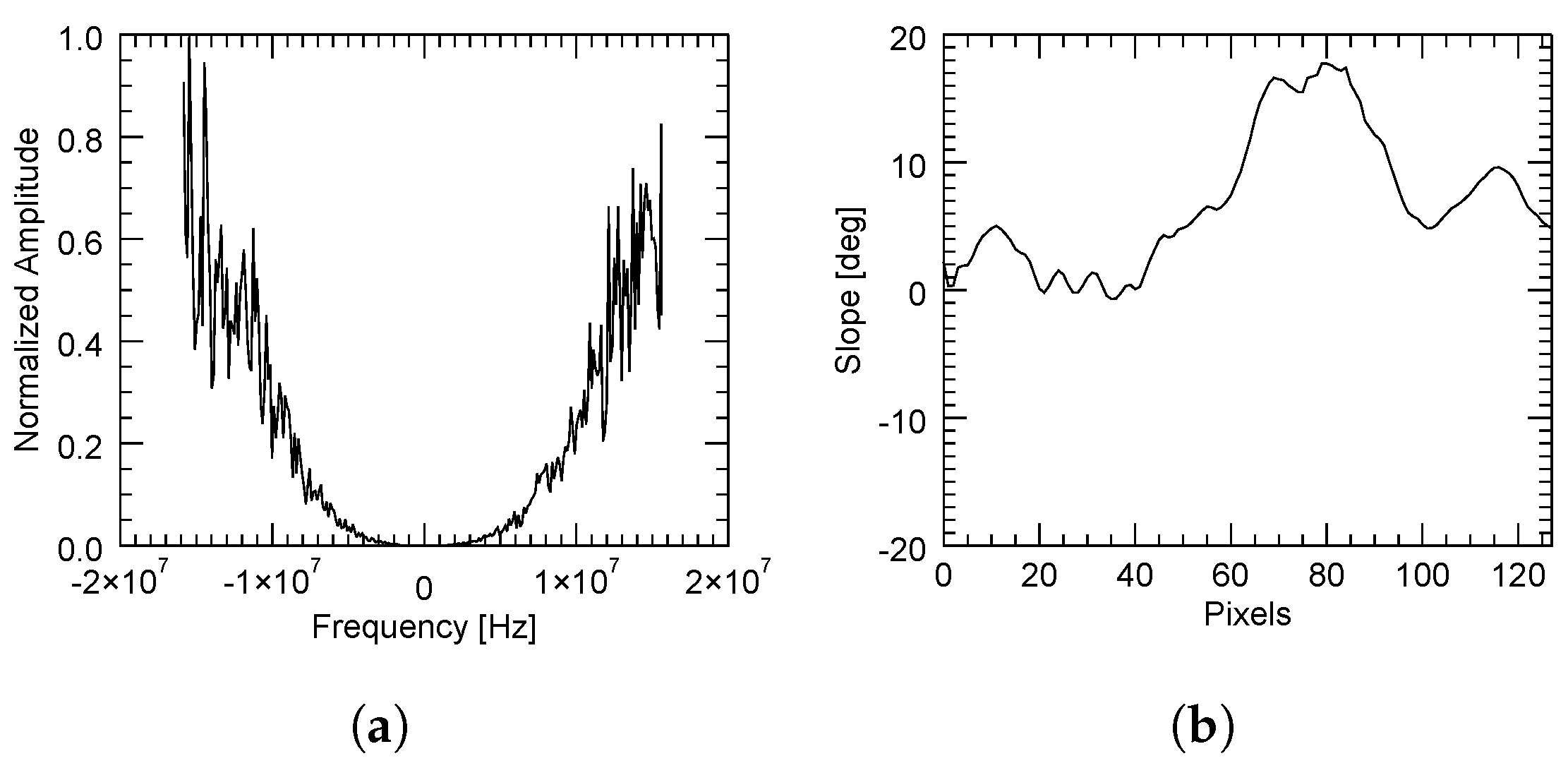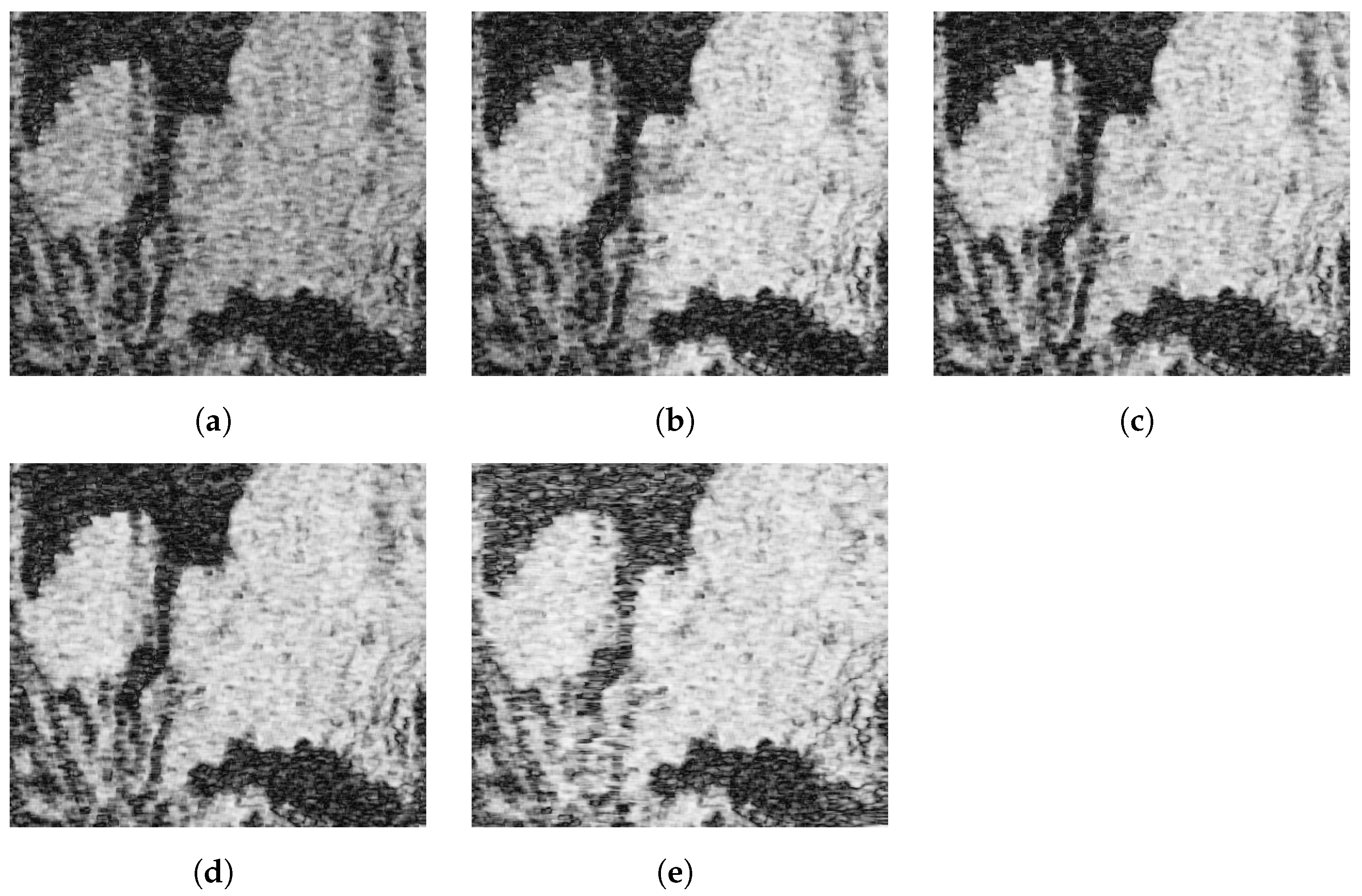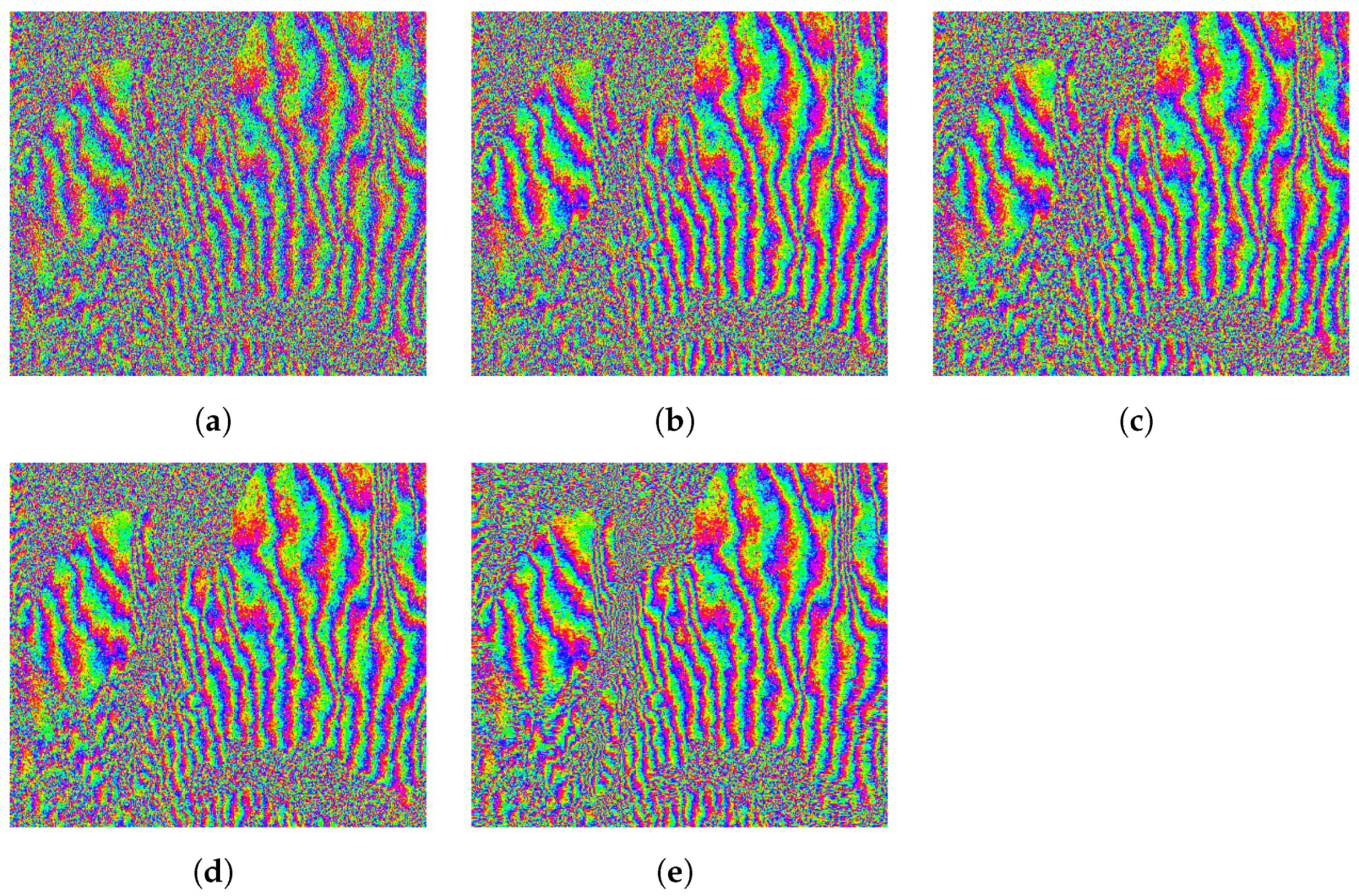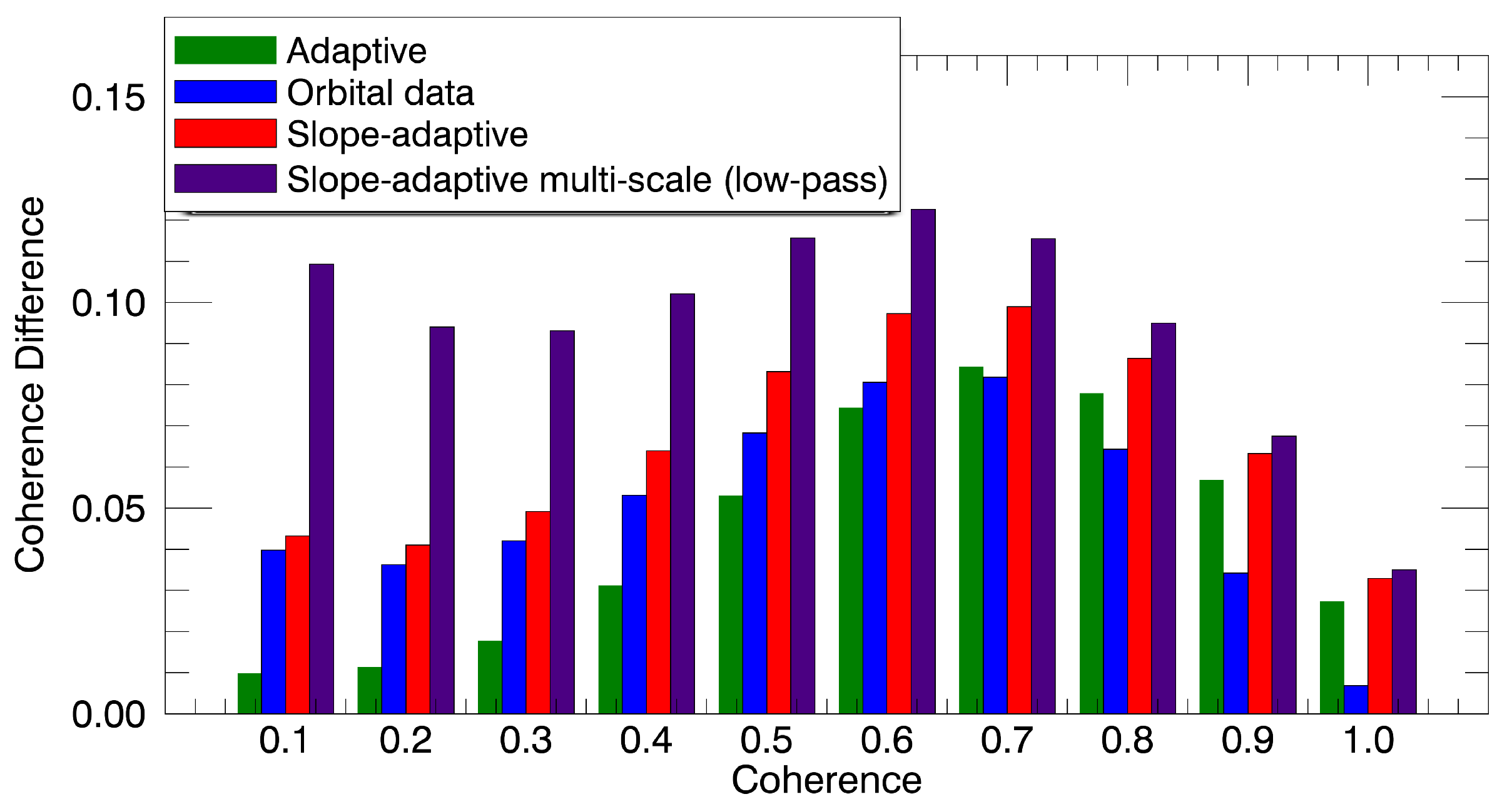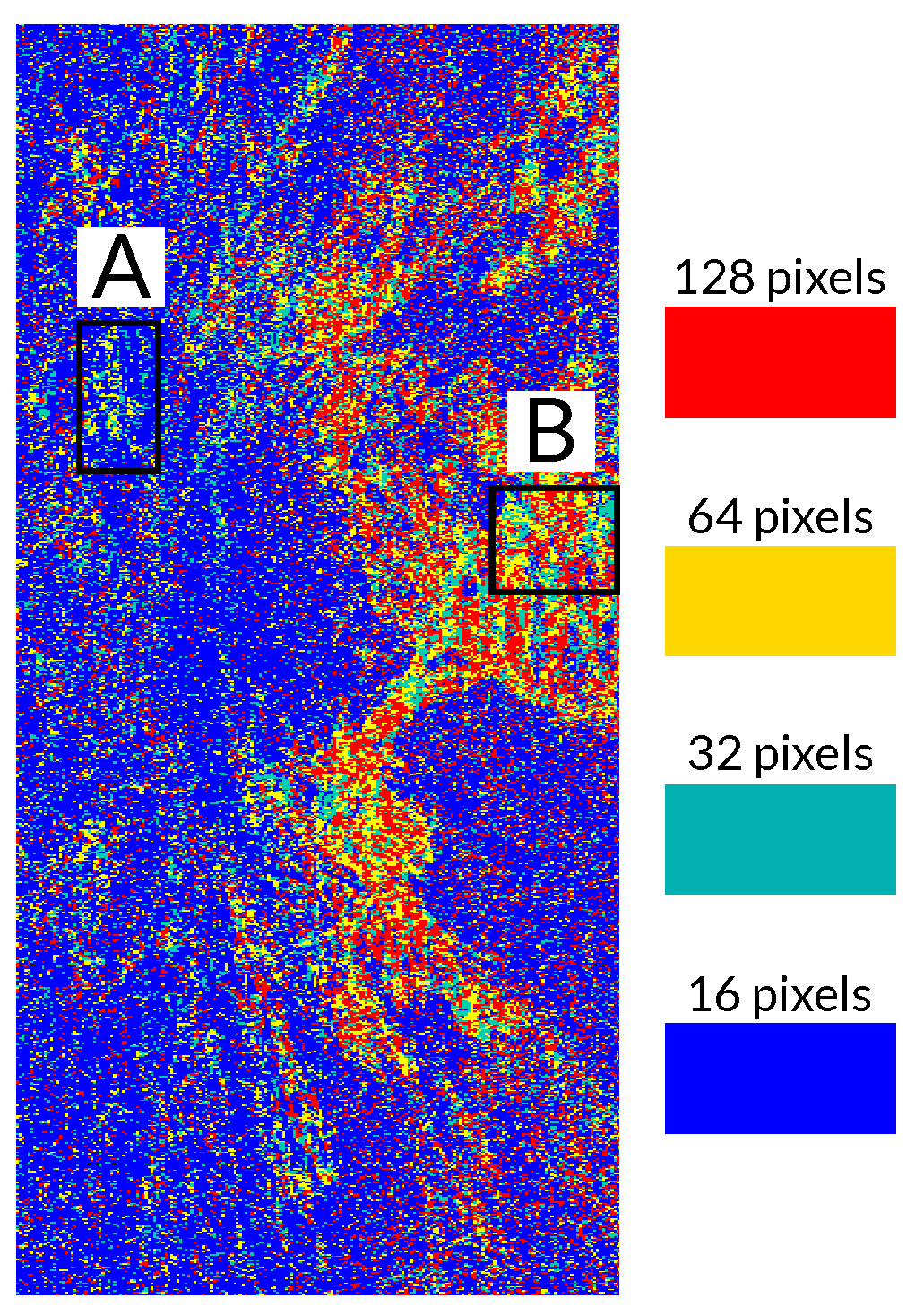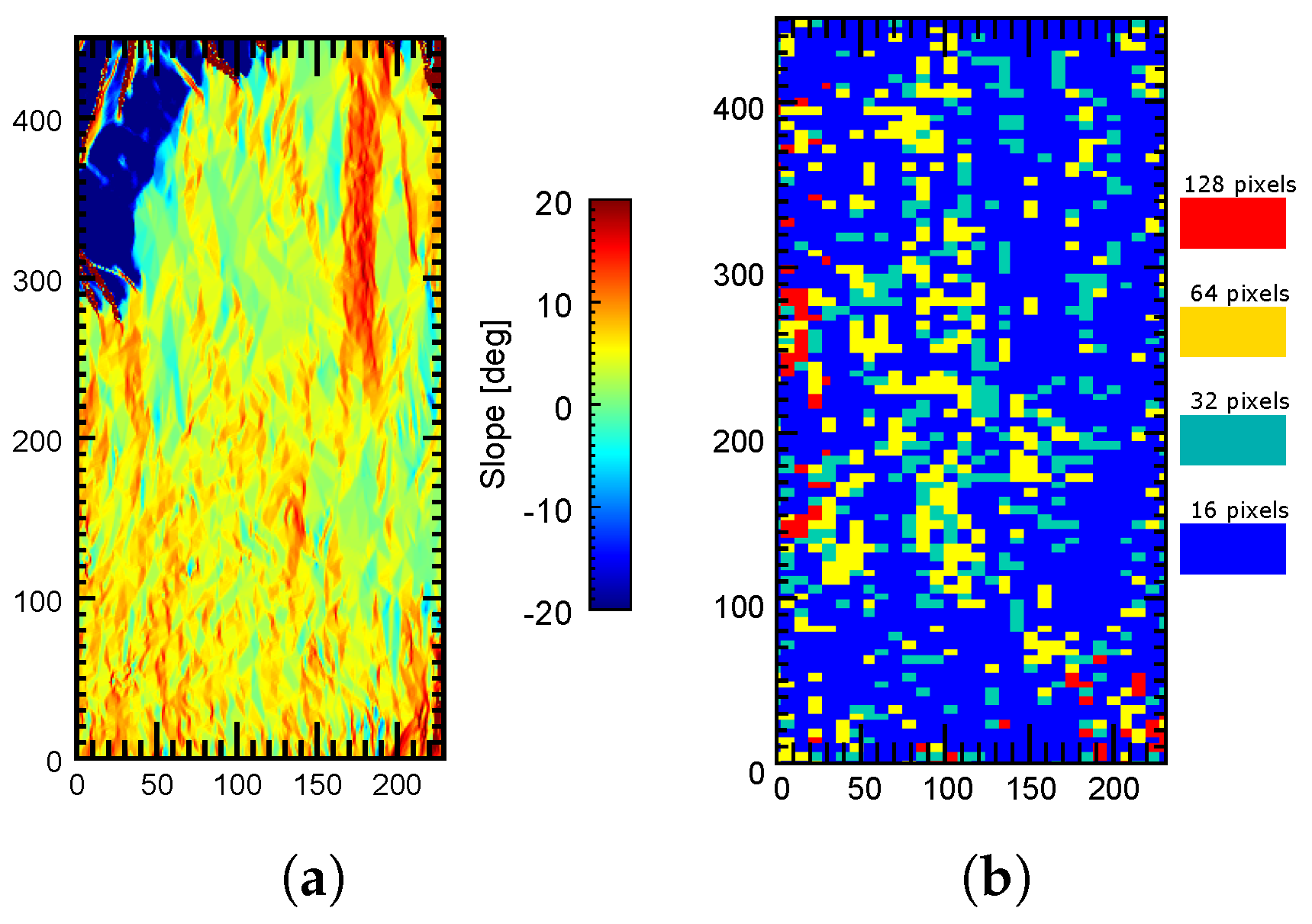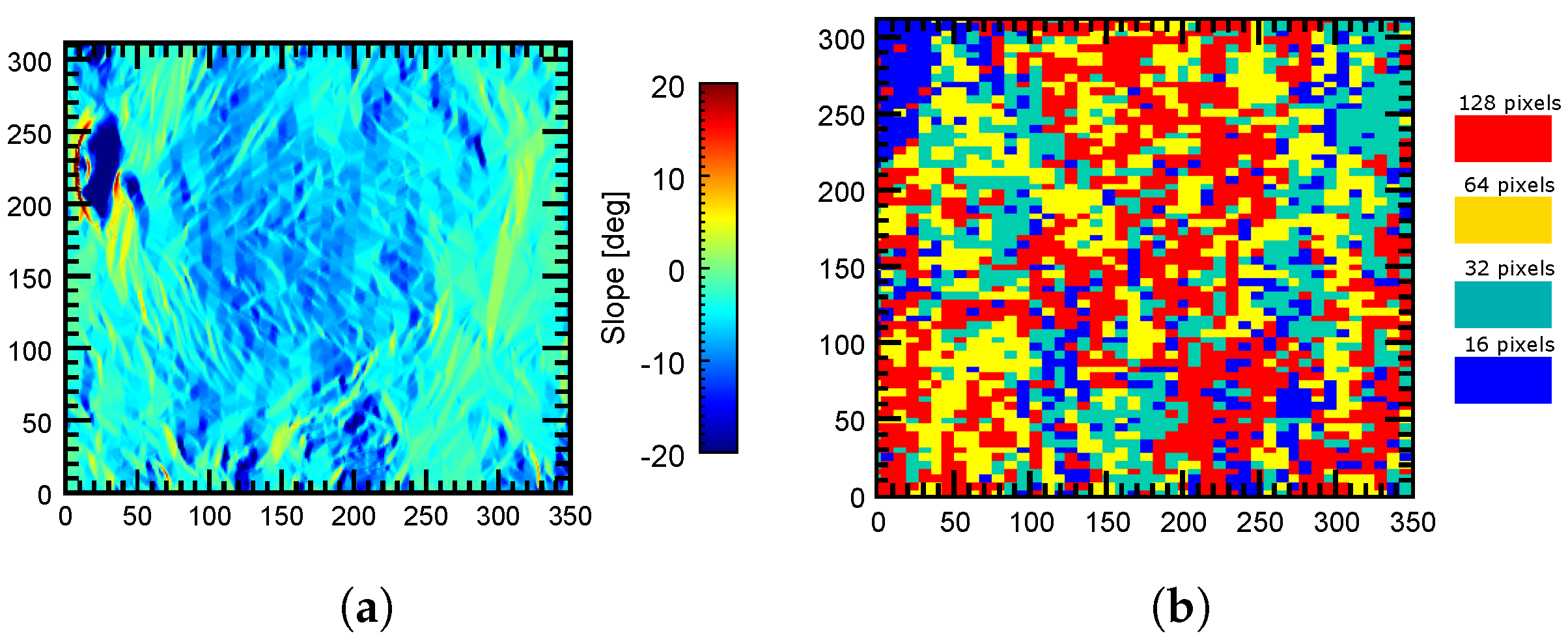1. Introduction
Synthetic Aperture Radar (SAR) interferometry (InSAR) has been established as a powerful remote sensing technique for mapping the Earth’s surface. InSAR applications include the generation of highly accurate topographic models, estimation of land subsidence, and analysis and monitoring of seismic deformations or volcanic activities [
1].
Interferometric methods exploit the phase information of interferograms, which are formed by combining two coregistered SAR images from the same area. Unfortunately, SAR interferograms are affected by different decorrelation sources (i.e., noise) that degrade the quality of the final products [
2]. They are briefly introduced here for the sake of completeness. A
miss-registration decorrelation is caused by errors in the coregistration of the two SAR images. It can be avoided by an accurate registration at the sub-pixel level, so it is usually negligible. An
SNR (signal-to-noise ratio) decorrelation is induced by the thermal noise present in the electronic systems located in the SAR instrument. It is noticeable in areas with low backscatter for which the SNR is low. A
volume decorrelation comes from the presence of scattering elements at different heights inside the SAR resolution cell, such as in the presence of a vegetation volume (e.g., in forests). A
temporal decorrelation is due to changes in the physical and geometrical properties of the imaged areas, which are produced from the acquisition of the two SAR images. Note that both volume and temporal decorrelations cannot be specifically compensated. A
Doppler decorrelation is due to variations in the antenna direction between the two acquisitions, which cause a different frequency shift in the azimuth spectrum (Doppler Centroid). This source of decorrelation can be appropriately compensated by using a process known as azimuth filtering, the goal of which is to remove the non-overlapping frequency bands in the azimuth dimension [
1,
3]. The last source of decorrelation, which constitutes the focus of this work, is the
geometrical (or baseline) decorrelation. It is caused by the InSAR acquisition geometry, that is, two SAR acquisitions obtained from slightly different positions. This difference in the incidence angles causes a frequency shift between the range spectra of the two images. When forming the interferogram, only the common band contributes to the interferometric phase, whereas the rest only contribute noise. This frequency shift depends not only on the satellite look angle difference but also on the local terrain slope [
4].
This has led to the conception of range-filtering strategies in frequency domains, which first, have to accurately estimate the spectral shift and second, properly remove the non-common band of the spectra while preserving the useful (common) part. The filtering step implies a degradation of the spatial resolution along the range. Without this range filtering, the coherence, and hence the global quality of the interferogram, would decrease proportionally to the perpendicular baseline (or equivalently to the local incidence angle difference). The suppression of a baseline decorrelation is, therefore, important for improving the quality of products derived directly from the interferometric phase (e.g., surface deformation). Moreover, there are techniques that exploit the coherence magnitude as an input feature for the retrieval of biophysical variables. A typical example is the estimation of vegetation height based on considering the input coherence as a direct measure of the volume decorrelation [
5,
6,
7,
8]. These techniques assume that the input coherence depends only on the volume decorrelation and is free from any other decorrelation sources (including baseline decorrelation). Therefore, the objective of range filtering is restricted not only to increase the coherence for obtaining a better phase quality but also to estimate the coherence correctly (i.e., free from other decorrelation sources).
This paper is organized as follows. First,
Section 2.1 analyzes the key aspects of range filtering for InSAR. The frequency-domain explanation of interferometry is briefly introduced to justify the need for range filtering. Then, the different range filters conceived in the past are explained in
Section 2.2,
Section 2.3.1 and
Section 2.3.2, whereas
Section 2.3.3 presents the proposed method. The good performance of the new method compared with those of the classical methods is evaluated in
Section 3, highlighting both the advantages and limitations of each one.
3. Results
To verify the performance of all methods including the proposed one, we analyzed the phase quality improvement achieved after range filtering a pair of images covering the area of Mount Etna (Sicily, Italy). Specifically, the data set was composed of two coregistered SLC (single-look complex) images acquired by RADARSAT-2 on 5 and 29 May 2008. They were acquired using Fine Quad Swath 8 (FQ8) mode, the near and far range incidence angles of which were 26.9
and 28.7
, respectively. The processed image size was 2000 × 4000 pixels (range and azimuth, respectively) and the polarimetric channel was HH. The main system parameters used in the filtering process are detailed in
Table 1. The intensity of the master image is represented in
Figure 10a, the unfiltered interferogram (after subtracting the flat-Earth phase component) is shown in
Figure 10b, and the DEM (SAR coordinates) providing the height data is depicted in
Figure 10c.
Moreover, the slant-range slopes of the test scene are represented in
Figure 11. It can be observed that this scene exhibited strong slopes throughout the whole area, especially around Mount Etna in the central part of the image.
It is important to mention that all the results discussed in this section are only related to the range-filtering process, that is, we only show the quality improvement after removing the baseline decorrelation. Concerning the adaptive method, blocks of 128 × 500 pixels (in range and azimuth dimensions, respectively) were progressively extracted and filtered, 35 azimuth lines in each block were averaged to compute the power spectrum, and both images were oversampled by a factor of 2 in the range dimension. Additionally, a minimum signal-to-noise ratio (SNR) threshold equal to 3, allowing the filter to proceed, was fixed. To show the impact of the window size (number of samples) on this method, its performance was also tested with a block size of 32 × 500 pixels, and 25 lines were averaged to compute the power spectrum. Concerning the method based on a constant flat DEM, each range line was divided into blocks of 128 pixels, and the spectral shift was estimated using Equation (
4) with a fixed (null) slope. Images were also filtered with the conventional slope-adaptive method after including the demodulation in the topographic phase. In this case, a global spectral displacement
was selected (the one providing the maximum shift). Furthermore, the proposed slope-adaptive multi-scale algorithm was applied as a band-pass and a low-pass filter, following both strategies described in
Section 2.3.3. Nevertheless, since they both provided the same results, we only show the results obtained with the low-pass version. Each extracted range line was filtered four times with windows of 128, 64, 32, and 16 pixels, and an overlap of 50% between adjacent blocks was set. To decide which block size performed better, the coherence along a line was estimated with a kernel of 15 samples.
The overall quality improvement was assessed with the coherence histograms shown in
Figure 12. A multi-look size of 9 × 5 pixels was used for coherence computation. It can be observed that all methods produced a clear improvement with respect to not filtering, as all histograms were displaced towards higher values. This also proves that the original data were significantly influenced by a geometrical decorrelation.
The adaptive method provided higher coherence values than the method based on a constant slope. This is because in high SNR areas, the computation of the power spectrum was accurate enough to yield a reliable estimate of the spectral displacement. However, it had the disadvantage of some lines not being filtered due to the reasons previously explained in
Section 2.2. This can be illustrated by three different cases as follows. In the first case, when there was a sufficient correlation between the images, the spectral displacement was very well determined, as shown in
Figure 13, where the slope was rather constant.
Contrarily, a bad estimation of the spectral shift may come from either a flat but decorrelated area (for instance, due to the presence of vegetation) or a correlated zone with a strongly variant topography. These are, respectively, illustrated in
Figure 14 and
Figure 15, in which the average power spectrum is noisy and a dominant peak cannot be correctly identified.
The improvement was also obvious in the resulting coherence maps of the processed area, which are depicted in
Figure 16. All methods showed an overall increase in coherence throughout the whole area. However, a further gain was obtained when including the multi-scale filtering.
This is better visualized by looking at the area indicated by a yellow square in the original coherence map in
Figure 16a. The coherences of this region of interest (RoI) are shown in
Figure 17, whereas the corresponding interferometric phases are represented in
Figure 18. It is clear that the fringes are sharper in the filtered data, so the global quality of the phase is improved, and hence the coherence is increased to a greater extent by the proposed method.
As an additional comparison, the improvement provided by each method at different coherence intervals was evaluated. Specifically, 10 coherence intervals were selected between 0 and 1. As shown in
Figure 19, the slope-adaptive methods provided the greatest improvement. Notably, the proposed algorithm was able to improve the coherence at all levels, outperforming the rest of the filters. The adaptive method exhibited the worst results in low-coherence areas, proving that this method is not able to filter areas strongly affected by other sources of decorrelation (improvement was almost negligible for coherence values below 0.3), for which the constant-slope orbit-based method provided some coherence improvements. On the contrary, the adaptive method performed better than the method based on orbits in highly coherent areas. In fact, it provided an improvement very similar to the slope-adaptive methods for coherence values greater than 0.8.
Quantitative measurement of the improvement after range filtering was provided by the so-called
phase residues [
23], which correspond to inconsistencies in the wrapped phase values and represent a way to identify erroneous measurements that could produce inaccuracies during the phase unwrapping step.
Table 2 shows the remaining residues after range filtering with each method. The improvements in both the whole area and the specific RoI shown in
Figure 18 are detailed.
Concerning the complete area, it was observed that the original number of residues was large, showing that the original phase was considerably degraded by noise. This is in line with the improvement offered by the adaptive method, which was the worst among all tested range filters as a result of the low-quality original interferogram (from which every spectral displacement was computed). The slope-adaptive method exhibited a greater improvement than the method based on orbits with a constant slope, proving that the inclusion of the slope information positively influences the filtering performance. The greatest improvement was clearly obtained with the proposed multi-scale strategy. By looking at
Table 2, it can be seen that the number of remaining residues was greatly reduced. In fact, the improvement in terms of residues was close to double that of the slope-adaptive method, showing that the multi-scale filter completely adapts to the local topography, so the filtering performance is greatly enhanced. A major improvement of the proposed method was also in the specific RoI obtained. As shown in
Table 2, among all the filters, the proposed slope-adaptive multi-scale method offered the best results since it was able to reduce the number of remaining phase residues to a greater extent, proving that the proposed methodology maximizes the range-filtering performance.
Finally, it is interesting to visualize the window size that provided the best results (i.e., the best coherence) in the processed area, so that the utility of testing multiple window sizes is justified. The color map in
Figure 20 shows the window size that provided the best filtering results in the whole processed area. By comparing
Figure 11 and
Figure 20 it can be deduced that there is a direct relationship between the filtering window size and the local terrain slope, as highlighted in
Section 2. In fact, small windows (especially of 16 pixels) produced the best results in most parts of the scene. This was expected since the images corresponded to a mountainous area where strong terrain slopes are present. Only flatter areas benefited from larger window sizes (128 and 64 pixels).
This is better illustrated when we compare the filtering window sizes and the slopes of the two regions, labeled A and B in
Figure 20. The first one (A) is located near the summit area of Mount Etna, so strong terrain slopes are present, as shown in
Figure 21a. In this case, by looking at
Figure 21b, the best filtering results were obtained with small windows (16 and 32 pixels have a clear dominance in this area). In fact, the largest window (128 pixels) was rarely used. On the contrary, in the flat area (B) shown in
Figure 22a, larger window sizes (128 and 64 pixels) seemed to perform better since more image blocks were filtered with these window sizes, as shown in
Figure 22b.
4. Discussion
A revision of different, state-of-the-art range-filtering methods, has been carried out in this work. We have shown the difficulties that these methods face, especially in areas strongly influenced by topography.
The conventional and widely used adaptive method has an important double drawback, that is, besides the difficulty of accurately estimating the spectral shift in areas with topography, the method is highly dependent on the original quality of the interferometric phase since it cannot estimate the shift if other sources of decorrelation are present. In other words, the filtering may be either inaccurate or unfeasible. However, it has the advantage of not requiring any external data. Concerning the method based on a constant DEM (i.e., a constant terrain slope) and satellite orbits, it is clearly limited if strong topographic variations are present because they are not taken into account. As a consequence, an inaccurate estimation of the spectral shift is computed and its solution is not optimum. The main advantage is that the algorithm is considerably faster than other methods and it should provide good results in flat areas.
It has been shown that in areas influenced by topography, slope-adaptive methods are undoubtedly needed. In this regard, the filter proposed in [
17], assuming that an external DEM is provided, offers good overall results. However, it only partially exploits the slope information derived from the DEM. In this regard, the proposed range-filtering method has shown that it can overcome all the limitations of the other filters and is able to extensively suppress the geometrical decorrelation of the interferometric pair. We have shown that the size of the filtering window (i.e., the number of samples used in the filtering process) has an influence on the final results, so the proposed multi-scale strategy automatically adapts the filter to all types of surface variations. Consequently, better performance is always obtained regardless of the smoothness of the topography, and even some useful interferometric fringes may be properly recovered in areas where the other filters are unable to achieve this. The main drawback is that the proposed method is computationally slower than the other ones, but it optimizes the range-filtering step in complicated areas with strong topographic variations.
In summary, we have seen that the removal of the geometrical decorrelation improves the phase quality and globally increases the coherence between the interferometric image pair. However, it is important to point out that besides improving the quality of the InSAR phase and the other products derived from it, such as the topography of an area or surface displacements in the case of differential interferometry, obtaining accurate coherence measurements is crucial in other applications. In fact, there is a wide variety of scientific applications that directly use coherence as an input feature and assume that all decorrelation factors that depend on the sensor parameters and acquisitions’ geometry are completely suppressed [
24]. A geometrical decorrelation is a type of sensor- and geometry-dependent term, as we have studied in this work. However, if properly compensated, the resulting coherence will not only be increased but, more importantly, also better estimated and only related to the specific characteristics of the imaged scene so it can be properly exploited. Coherence-based applications include physical parameter estimations (such as vegetation height, biomass, etc. [
5,
6,
7,
8]) and land-cover classifications [
25,
26], among others. The removal of a geometrical decorrelation using an accurate range-filtering method will therefore be beneficial not only for interferometry but also for other practical applications that require coherence data that are not affected by decorrelation sources that are not dependent on the scene variables to be estimated.
